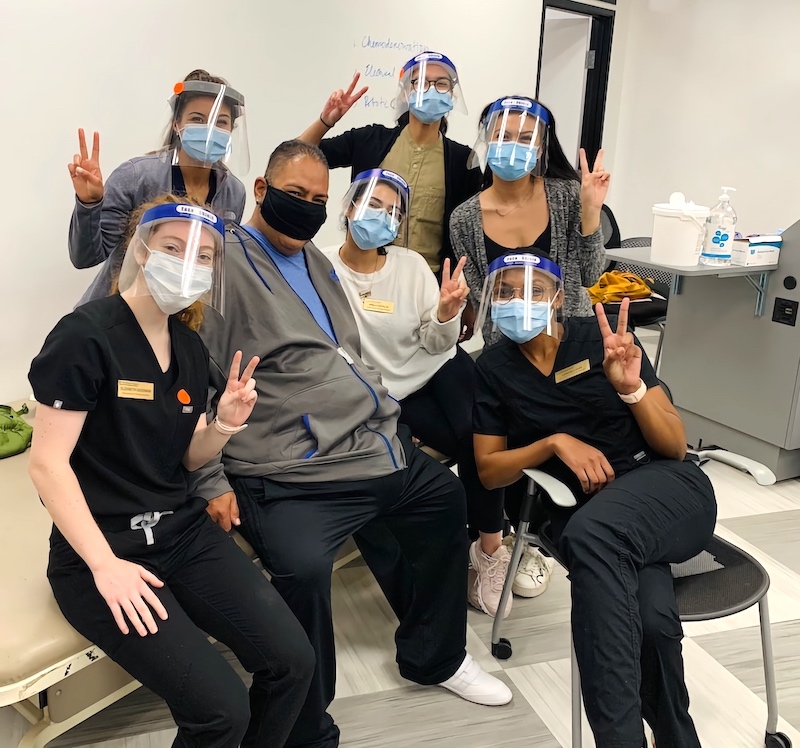Working with Real Clients (not actors)

October 23, 2020
by Lamoni
During your time in the Master’s Program and in the Adult Rehabilitation immersion, specifically, you will have several opportunities to work with actors that will serve as your client. This allows you to practice the techniques that your instructors and textbooks have been talking about. It is pretty nerve wrecking in the beginning because you do not want to “mess up.” But this is technically what they are there for. If you do it incorrectly the first, second, third time, it is okay. Each time that you practice, you get closer to using the correct form or using the correct language. The great thing is that the actors give you feedback too! You do not have to wait until your professor comes over. The actors will let you know if your directions were not clear or if your position was awkward and what you should try next time.
While it is great practice to have those actors as clients, it definitely does not compare to working with actual clients. During my Level I fieldwork at a hospital, I was presented with new challenges that I had not thought about. Clients would ask questions that I did not have the answers to, they would get off track and sometimes it was difficult to redirect them, and there were times when they said things that were a cause for worry. However, my clinical instructor was always right there to guide those situations. For the most part, I was observing and taking mental notes.
Due to COVID-19, the structure of the program has changed. Instead of doing my first Level II fieldwork during the summer, I will not be starting until the spring. That means that I went a couple of months without seeing a client (whether real or an actor). I was feeling rusty. However, I have had the perfect opportunity to work in the middle ground during this semester! My elective, Enhancing Motor Control for Occupations, has in-person sessions and involves volunteer clients!
We began this course by discussing what we would cover and how everything would be laid out. The purpose of the course is to provide an in depth understanding of “principles and methods for remediation of motor control problems following upper motor neuron lesions” (OT574 Syllabus, 2020). The perspective of the course is to examine the ways that occupations are impacted for adults with hemiplegia. Our first two classes covered pelvic and trunk assessment, scapular assessment, and shoulder alignment. We had practiced facilitations and mobilizations on our assigned partners which were other students in the class but because everyone had normal strength and movement (and none of us were trained actors), it felt rather . . . easy? It took some time to get the proper form but other than that, the client (ourselves) was simple.
After those first two classes, our volunteer clients arrived! The client that I was assigned to had a much different presentation than my classmate. While my partner is 5’6 and no more than 130 pounds, my client, Chuy, was 6’1 and over 300 pounds. He had a stroke a couple of years ago and presented with left side hemiplegia that caused weakness in his arm and flexion in his hand. He wanted to be able to tie his shoes and zip up his jacket independently. He had very functional goals and it was time to help him achieve them! Our interventions were completed through both in-person and Telehealth sessions. Every week, we had an entire two hours to work with our clients. Afterwards was the lecture portion by our instructor Remy Chu.

Group photo of my team and Chuy! (Left to right: Elizabeth Goodman, Sydney Bast, Emeli Castillo, Daphne Carcedo Cravens, Brianna Hernandez, and Lamoni Lucas)
The last session with clients ended this week; we wrote discharge notes and gave them home exercise plans. Spending time with clients in this environment was an amazing opportunity. Everything we learned in lecture was being applied on the spot. And none of the clients had to pretend that they had weakness or impaired sensation or limited range of motion because it was actually the case. Therefore, by the end of our time with them, we were able to see real progress! We started and ended our time with clients by recording their movement and the how they performed their goal. We were able to compare them at discharge to how they were at baseline. In our last session which was through Telehealth, Chuy independently tied his shoes and with a big smile, asked “did you see that?!” It was such a rewarding feeling! I almost shed a tear. That feeling is not something that actors can provide. When working with clients, I am constantly reminded of why I chose this field.
⋯
Next by tag Classes ⟩
⋯





